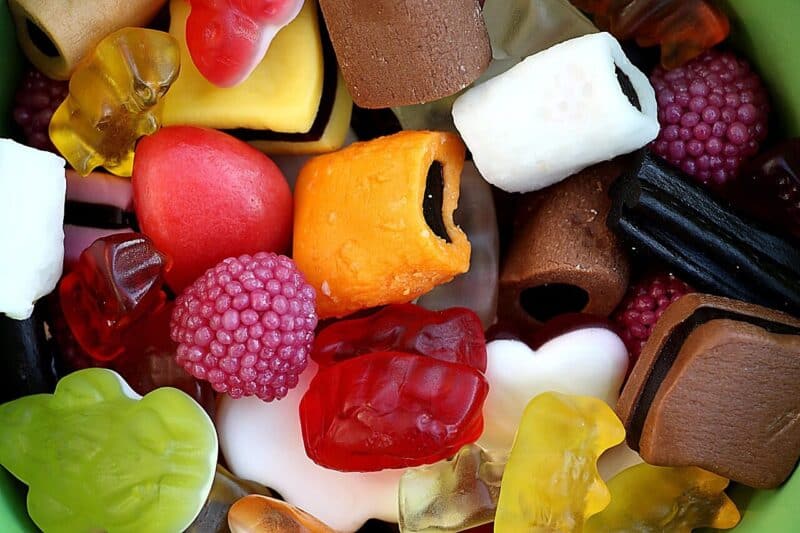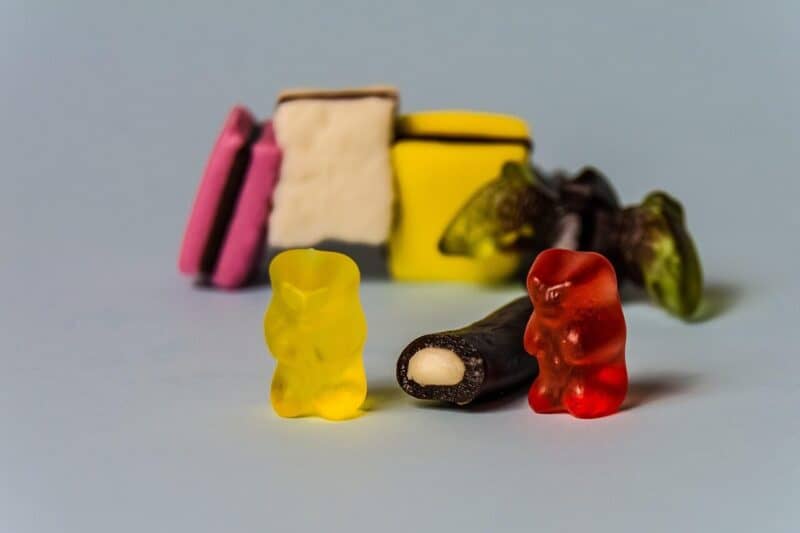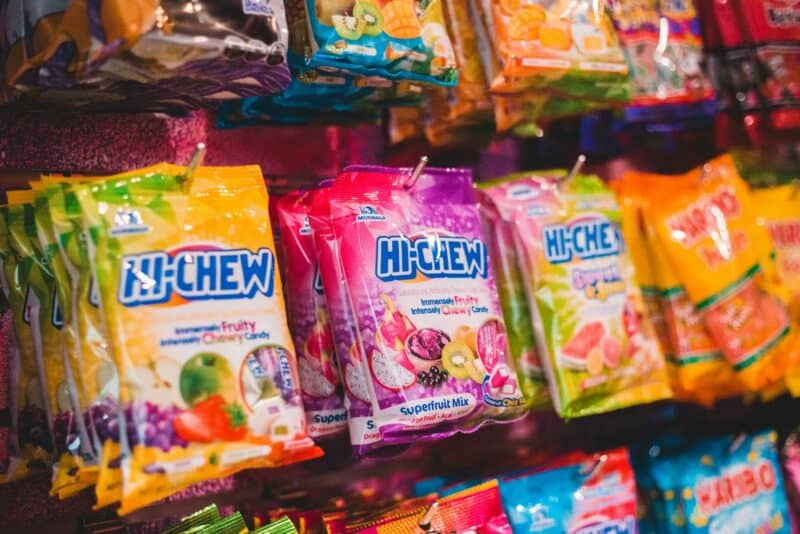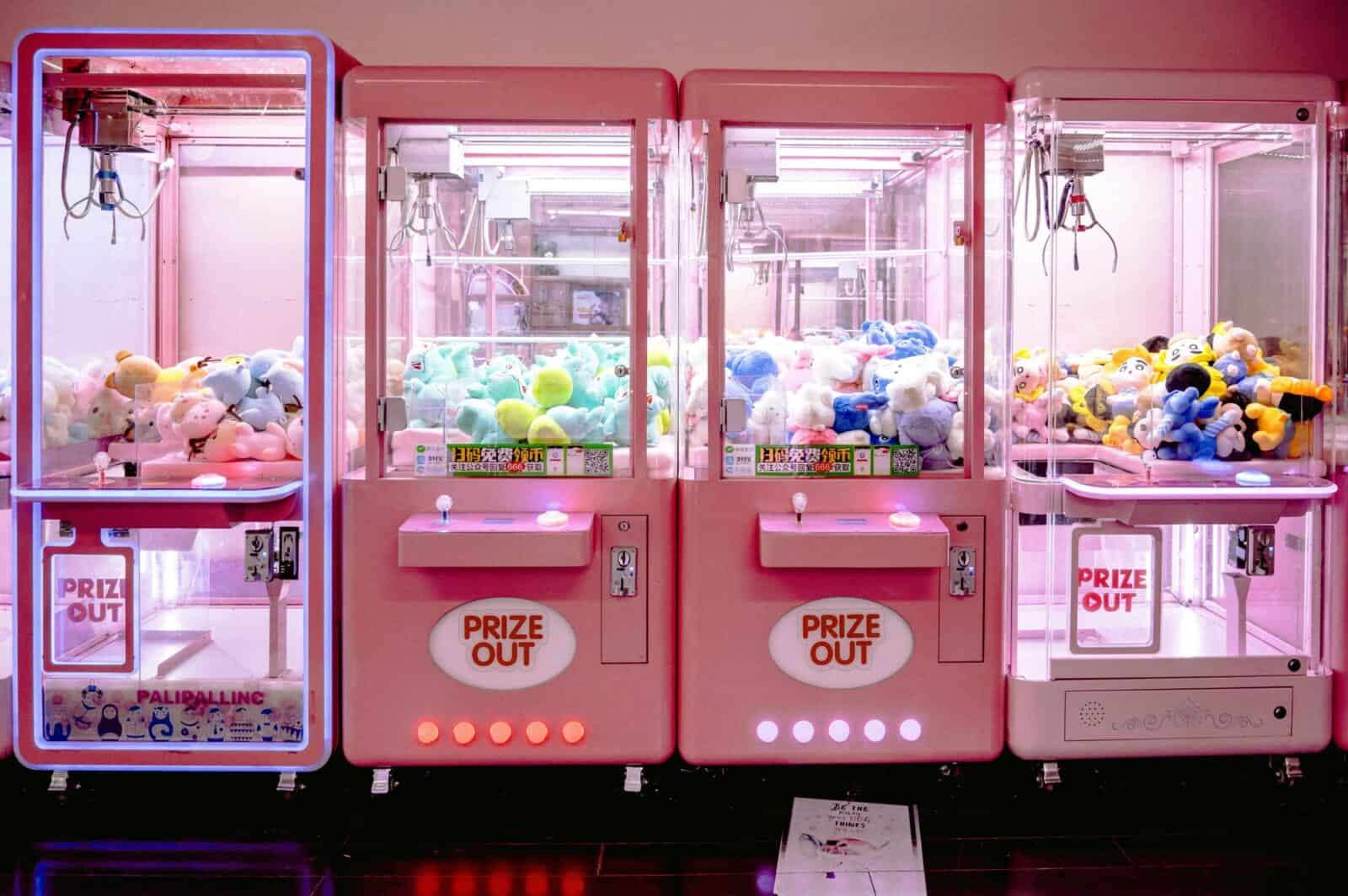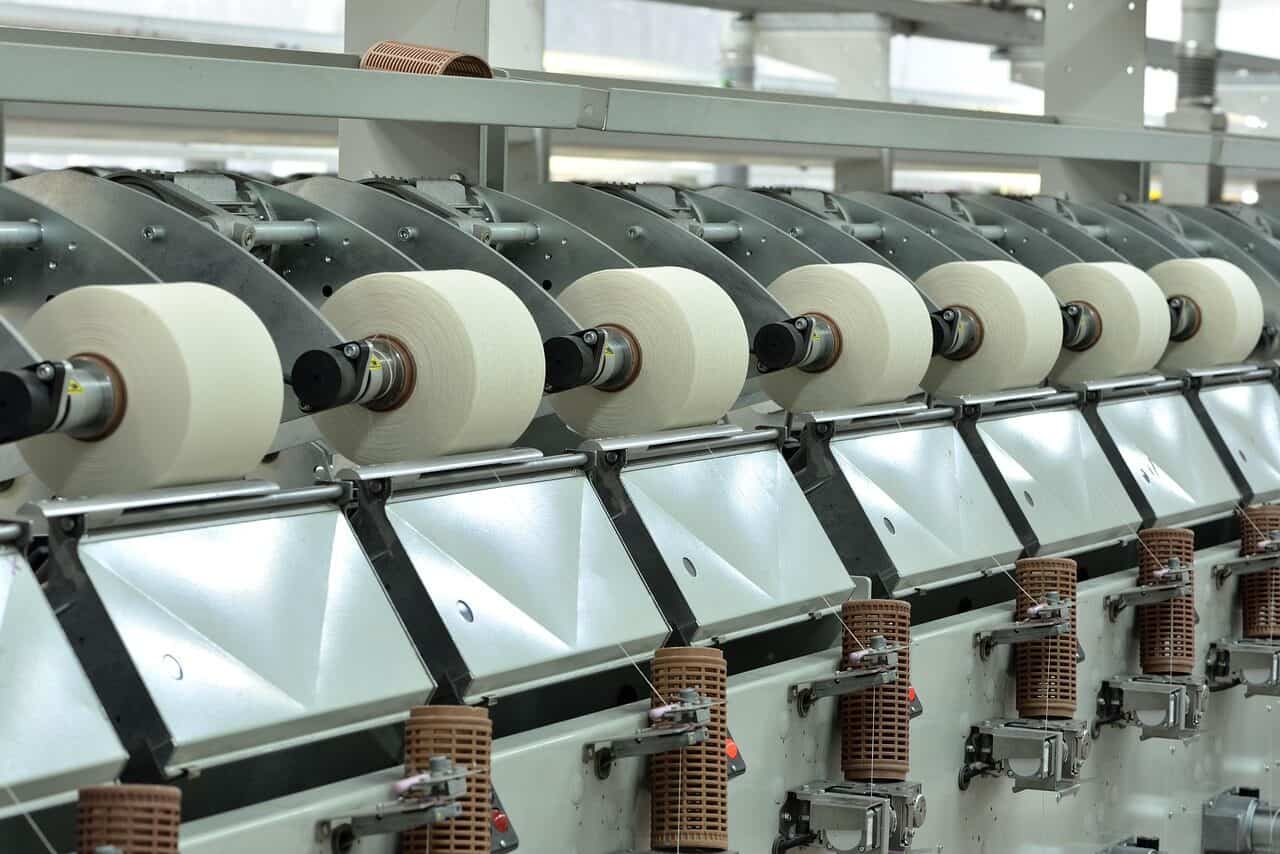Haribo retira caramelos del mercado: ¿Se estropean las gominolas? Guía sencilla sobre frescura y seguridad

El misterio de la bolsa olvidada
Todos nos hemos encontrado en esta situación. Buscas en la despensa y encuentras una vieja bolsa de gominolas que habías olvidado. Te alegras al recordar cuándo las compraste, pero luego te preocupas. Tienen buen aspecto, pero la fecha de caducidad es de hace seis meses. Te paras a pensar, "¿Puedo seguir comiéndolos sin peligro?"
Esta pregunta surge con muchos alimentos que duran mucho tiempo. Se vuelve más importante cuando oímos noticias preocupantes, como una posible retirada de caramelos Haribo o historias similares sobre seguridad alimentaria. Estos sucesos nos recuerdan que conocer nuestros alimentos, incluida su evolución a lo largo del tiempo, nos ayuda a elegir mejor. No se trata de asustarle, sino de ayudarle a sentirse seguro como comprador. Este artículo te ayudará a entender este tema. Explicaremos las fechas de los envases, veremos cómo cambian las gominolas a medida que envejecen, te daremos formas de comprobar si aún están frescas y compartiremos consejos de expertos sobre su conservación. Al final, sabrás exactamente cómo responder a esa importante pregunta.
"Consumir preferentemente antes de" vs. Caducidad
Para responder a nuestra pregunta principal, primero tenemos que entender qué significan las fechas de los envases. No todas las fechas impresas en los caramelos significan lo mismo y, en el caso de productos azucarados como las gominolas, conocer la diferencia es muy importante.
Entender las fechas
- "Consumir preferentemente antes de" / "Consumir preferentemente antes de": Esta es la fecha más común que verá en los caramelos de goma. Sólo indica la *mejor calidad*. La empresa promete que antes de esta fecha, el caramelo tendrá el mejor sabor, el tacto suave y masticable adecuado y mantendrá su color brillante. No se trata de seguridad.
- "Use By": Esta fecha es más estricta y suele estar relacionada con la seguridad alimentaria. La verás en alimentos que se estropean rápidamente, como la carne, los lácteos y las ensaladas frescas. Casi nunca encontrarás una fecha de caducidad en los caramelos de larga duración, como las gominolas, porque no desarrollan bacterias dañinas de la misma manera.
- "Sell By": Esta fecha ayuda a las tiendas, no a los clientes. Ayuda a las tiendas a gestionar sus productos y asegurarse de que rotan las existencias adecuadamente. No afecta a la seguridad ni a la calidad de los caramelos una vez en casa.
Por qué las gominolas son especiales
Los caramelos de goma duran mucho tiempo, y la ciencia que hay detrás de esto es interesante. La idea clave se llama "actividad del agua". Aunque las gominolas contienen agua, la mayor parte está adherida químicamente a moléculas de azúcar (como el azúcar normal y el jarabe de maíz) y gelatina o pectina. Esto deja muy poca agua "libre" para que organismos diminutos como las bacterias, el moho y la levadura la utilicen para crecer.
Según las normas de la ciencia alimentaria reconocidas por organizaciones como la FDA, los alimentos con baja actividad de agua resisten de forma natural al deterioro. Piense en cómo la miel, que es casi todo azúcar, puede durar cientos de años. Los caramelos de goma funcionan de la misma manera, sólo que no tan extremadamente. La elevada cantidad de azúcar actúa como un conservante natural, secando eficazmente cualquier célula dañina que intente formarse. Por eso, una bolsa de gominolas bien cerrada puede seguir siendo segura mucho después de que haya pasado su fecha de caducidad. El problema no es la seguridad, sino que la calidad empeora.
Cómo cambian las gominolas con el tiempo
Entonces, si las gominolas no suelen "estropearse" de forma peligrosa, ¿qué les ocurre realmente con el paso del tiempo? Los cambios que se observan son el resultado de procesos físicos y químicos lentos y predecibles. Comprenderlos ayuda a explicar por qué ese viejo osito de gominola se parece más a una roca que a una golosina masticable.
Pérdida de humedad
La principal razón por la que una gominola se vuelve rancia es la pérdida de humedad. El gelatina o estructura de pectina que mantiene unida la gominola no es un cierre perfecto. Con el tiempo, las moléculas de agua se evaporan lentamente del caramelo y escapan al aire que lo rodea, sobre todo si el envase no es completamente hermético. Este proceso, llamado endurecimiento o deshidratación, hace que la gominola pierda su capacidad de doblarse. La estructura se vuelve más rígida y densa, creando esa clásica textura dura, tenaz y desagradablemente difícil de masticar.
Cambios en el azúcar
¿Ha visto alguna vez una fina capa blanca parecida a un cristal en un caramelo viejo? No es moho. Es cristalización del azúcar. Durante largos periodos o con cambios de temperatura, las moléculas de azúcar disueltas en la gominola pueden decidir reagruparse. Se desplazan a la superficie y forman estructuras cristalinas organizadas. Esto crea una textura arenosa o crujiente que altera la masticación suave que se espera. Aunque se puede comer sin problemas, es una clara señal de que la gominola ya ha pasado su mejor momento.
Desvanecimiento de sabores y olores
Los sabores y olores brillantes y afrutados de los caramelos de goma proceden de compuestos volátiles. Como su nombre indica, "volátiles" significa que estas moléculas pueden evaporarse fácilmente y desaparecer con el tiempo. Cuanto más tiempo se almacena una gominola, más de estos compuestos de sabor y olor se pierden en el aire. El resultado es un caramelo que sabe soso, débil o "rancio". El sabor se vuelve plano y aburrido, una versión débil de su antiguo ser afrutado.
El Caso Raro: Volverse rancio
Esto es menos frecuente en los ositos de gominola normales, pero puede ocurrir en las gominolas que contienen grasas o aceites, como las recubiertas con ciertas ceras o las que contienen mezclas de sabores específicos. Las grasas y los aceites pueden sufrir un proceso llamado oxidación cuando se exponen al aire, lo que provoca ranciedad. Una gominola rancia desprenderá un olor desagradable, a menudo descrito como olor a ceras de colores viejas, pintura al óleo o frutos secos rancios. El sabor será igualmente agrio o amargo.
Su caja de herramientas de cheques
Aunque la fecha de la bolsa es un punto de partida, sus propios sentidos son las herramientas más fiables para comprobar la calidad de sus caramelos de goma. Con una sencilla inspección de cuatro pasos, puedes decidir con seguridad si una gominola sigue siendo una golosina deliciosa o si debe tirarse a la basura.
Inspección en cuatro etapas
Antes de meterte en la boca una gominola dudosa, tómate un momento para hacer de detective. Esta cuidadosa comprobación le dirá todo lo que necesita saber.
Tabla 1: Guía de detección del deterioro de los caramelos de goma
| Método de control | Signos de frescura | Señales de hacerse viejo (rancio pero probablemente seguro) | Señales de advertencia (tirar inmediatamente) |
| Visual (Look) | Color brillante y uniforme; superficie brillante. | Color apagado o desvaído; película blanca y azucarada (cristalización). | Moho visible (manchas difusas de cualquier color); cambios extraños de color; señales de bichos. |
| Tacto (Feel) | Suave, flexible y masticable; cede al presionarla. | Duro, duro, quebradizo; demasiado pegajoso o "sudoroso". | Textura viscosa; líquido que sale del caramelo. |
| Oler | Huele afrutado y dulce, como era de esperar. | Olor débil o nulo. | Olores agrios, fermentados, químicos o rancios (aceitosos/crayones). |
| Gusto (Cuidado) | El sabor es brillante y coincide con el olor. | El sabor es soso, débil o "plano". | Cualquier sabor agrio, amargo, químico o "apagado". Escúpelo inmediatamente. |
La columna "Signos de envejecimiento" describe una gominola que ya no es de la mejor calidad, pero que casi con toda seguridad se puede comer. Una gominola fresca debe ceder suavemente al presionarla, mientras que una rancia se siente dura, casi como una pequeña roca. La columna "Señales de advertencia", sin embargo, muestra una posible contaminación. Cualquier signo de moho, sensación viscosa u olor a fermentado significa que el caramelo ha sido dañado por la humedad y debe desecharse sin dudarlo.
¿Y si comes gominolas viejas?
Este es el principal temor que subyace a la pregunta: ¿cuáles son los riesgos para la salud? La buena noticia es que, en el caso de los caramelos de goma, los riesgos son muy bajos y están relacionados principalmente con la calidad, no con la seguridad.
Un tentempié decepcionante
En la mayoría de los casos, comer un caramelo de goma caducado tiene como resultado una experiencia decepcionante. Es probable que encuentre un producto duro, difícil de masticar y sin sabor. Puede tener una textura ligeramente arenosa debido a la cristalización del azúcar. Es una decepción alimentaria, no una crisis de salud. Puede que tus dientes se resientan más de lo que esperabas, pero es casi seguro que tu estómago estará bien. Este es el resultado más probable.
Cuándo preocuparse
El verdadero peligro, aunque pequeño, de las gominolas viejas no es su antigüedad, sino la contaminación debida a un mal almacenamiento. Si el envase está dañado y deja pasar la humedad y los gérmenes del aire, pueden surgir problemas.
Aquí es donde su caja de herramientas de comprobación es esencial. Si ve moho visible, siente una textura viscosa u huele algo fermentado, agrio o químico, no coma el caramelo. Son señales de que se ha roto el sistema de defensa de baja actividad de agua del caramelo. Comer caramelos con estas "señales de advertencia" podría provocar malestar estomacal u otros síntomas de enfermedades transmitidas por los alimentos, aunque esto es poco frecuente debido a su alto contenido en azúcar. La clave está en distinguir entre un caramelo que está simplemente *rancio* (duro, insípido) y un caramelo *en mal estado* (mohoso, viscoso, maloliente). Los rancios son seguros; los estropeados, no.
Cómo guardar bien las gominolas
La mejor manera de evitar el problema de las gominolas rancias es almacenar los caramelos correctamente desde el principio. Un almacenamiento adecuado puede prolongar enormemente el periodo de mejor calidad, manteniendo sus golosinas frescas, blandas y sabrosas durante el mayor tiempo posible.
Los tres enemigos
Para proteger tus gominolas, debes defenderlas de tres enemigos principales:
- Aire: El oxígeno acelera la descomposición de los compuestos del sabor y puede contribuir al enranciamiento de las gominolas que contienen grasas. La exposición al aire también acelera la pérdida de humedad, lo que provoca su endurecimiento.
- Calor: Las temperaturas cálidas pueden hacer que las gominolas se derritan, se vuelvan demasiado pegajosas y "suden". El calor también acelera las reacciones químicas, haciendo que los sabores y colores se descompongan más rápidamente.
- Luz: La luz solar directa e incluso la iluminación interior intensa pueden blanquear los colores de las gominolas y descomponer los delicados compuestos de sabor.
Las reglas de oro del almacenamiento
- Mantenlo hermético: Una vez abierta la bolsa, pasa las gominolas a un recipiente con tapa hermética. Un tarro de cristal, un recipiente especial para caramelos o incluso una bolsa resistente con cierre de cremallera funcionan bien. Exprima todo el aire posible.
- Manténgalo fresco y seco: Una despensa o un armario es el entorno perfecto. La temperatura debe ser estable y fresca. Evite guardarlas cerca de una estufa, encima del frigorífico o en un sótano húmedo. Aunque le tiente, el frigorífico suele estar demasiado frío y puede hacer que las gominolas a base de gelatina queden demasiado firmes.
- Mantenlo en la oscuridad: Un recipiente a través del cual no se pueda ver o un armario oscuro protegerán tus gominolas de la luz, manteniendo su color y sabor.
No todas las gominolas son iguales
Los distintos tipos de gominolas tienen necesidades de almacenamiento y vida útil ligeramente diferentes. Entender estas diferencias muestra un nivel más profundo de cuidado de los caramelos.
Cuadro 2: Duración de diferentes caramelos de goma
| Tipo gominola | Ingredientes clave | Vida útil típica sin abrir | Tras la apertura Buenas prácticas | Notas |
| A base de gelatina (por ejemplo, Haribo Goldbears) | Gelatina, azúcar, jarabe de maíz | 12-18 meses | Consumir en un plazo de 3 a 6 meses en un recipiente hermético. | Muy estable, pero se endurece con la exposición al aire. La clásica masticación firme. |
| A base de pectina (por ejemplo, muchos "aperitivos de fruta") | Pectina, Azúcar | 9-12 meses | Consumir en un plazo de 2-4 meses. | Textura más blanda y gelatinosa. Puede volverse pegajosa o "supurar" más fácilmente si se expone al calor. |
| Sin azúcar (con alcoholes de azúcar) | Sorbitol, maltitol, gelatina | 6-9 meses | Consumir en un plazo de 1-3 meses. | Vida útil más corta. Es más probable que los alcoholes de azúcar cristalicen y cambien de textura. |
| Gominolas caseras | Gelatina, Zumo/Puré | 1-2 semanas (refrigerado) | Conservar refrigerado en un recipiente hermético. | La falta de conservantes comerciales y de un control preciso de la actividad del agua acorta mucho la vida útil. Trátese como un artículo perecedero. |
Cómo hacen las empresas que las gominolas duren
La larga vida útil de un caramelos de goma comerciales no es una casualidad. Es el resultado de una cuidadosa ciencia alimentaria y de un proceso de control de calidad a varios niveles que comienza mucho antes de que se embolsen los caramelos. Para las grandes marcas, garantizar la estabilidad y la seguridad es muy importante.
De la receta a la tienda
El compromiso con la calidad está integrado en la propia fórmula del caramelo. Los fabricantes no se limitan a mezclar azúcar y gelatina, sino que crean un sistema cuidadosamente diseñado para la longevidad. El objetivo es producir un producto consistente que resista el viaje de la fábrica a su despensa manteniendo la calidad prevista durante muchos meses.
Métodos de control de calidad
Los fabricantes utilizan varios métodos clave para prolongar la vida útil y garantizar la seguridad. Estos sistemas también permiten una respuesta rápida en el raro caso de que se produzca un problema.
Tabla 3: Control de calidad en la producción comercial de gominolas
| Fase | Método | Propósito |
| Creación de recetas | Uso de humectantes y conservantes | Ingredientes como el jarabe de maíz y el sorbitol (humectantes) ligan el agua para mantener la suavidad. Ácidos como el ácido cítrico no solo aportan acidez, sino que también reducen el pH, lo que frena aún más el crecimiento nocivo. |
| Producción | Estricto control de la temperatura y la humedad | La mezcla de gominolas se cuece a una temperatura precisa para alcanzar un contenido final de humedad exacto. Este nivel objetivo de "actividad de agua" es el factor más importante para garantizar la estabilidad a largo plazo. |
| embalaje | Envasado en atmósfera modificada (MAP) | Antes de sellar la bolsa, algunos fabricantes la enjuagan con un gas inerte como el nitrógeno. De este modo se desplaza el oxígeno, lo que ralentiza drásticamente la oxidación que puede provocar sabores rancios o enranciamiento. |
| Pruebas | Estudios de vida útil acelerada | Para validar las fechas de caducidad, las empresas colocan muestras de producto en cámaras con calor y humedad elevados. Esto simula meses o incluso años de almacenamiento en tan solo unas semanas, lo que les permite predecir con seguridad cómo envejecerán los dulces. |
| Seguimiento | Codificación de lotes y seguimiento de lotes | Cada bolsa de caramelo lleva impreso un código que identifica la fecha de producción, la fábrica y el lote específico. En un caso como el de "Haribo retira caramelos", este código permite a la empresa rastrear instantáneamente el origen del problema, identificar todos los productos afectados y retirarlos del mercado con precisión y rapidez, protegiendo a los consumidores. |
Tendencias futuras para mantener frescas las gominolas
El mundo de los caramelos siempre está cambiando, impulsado por lo que quieren los consumidores y las nuevas tecnologías. El futuro de la conservación de las gominolas se centra en ingredientes más limpios, envases más inteligentes y nuevos retos funcionales.
El empuje de las "etiquetas limpias
Los consumidores están cada vez más preocupados por los ingredientes artificiales. Esto ha dado lugar a una importante tendencia a sustituir los conservantes, aromas y colorantes artificiales por alternativas naturales. En lugar de conservantes sintéticos, las empresas están probando extractos vegetales como el extracto de romero o los tocoferoles (vitamina E), que tienen propiedades antioxidantes. El reto para los científicos de la alimentación es conseguir el mismo nivel de estabilidad y calidad utilizando estos ingredientes naturales, que a veces pueden ser menos fuertes o más sensibles al procesado.
Envases sostenibles e inteligentes
El impacto medioambiental de los envases es una preocupación creciente. La industria está invirtiendo mucho en el desarrollo de nuevos materiales biodegradables, compostables o fabricados a partir de contenido reciclado, al tiempo que proporcionan la alta barrera contra la humedad y el oxígeno necesaria para proteger los dulces. De cara al futuro, es posible que veamos el auge de los envases "inteligentes". Imaginemos un pequeño indicador en una bolsa de gominolas que cambie de color con el tiempo o si se rompe el precinto, lo que nos daría una señal visual en tiempo real de la frescura del producto.
Desafíos funcionales de las gominolas
El formato gominola se ha hecho muy popular para suministrar vitaminas, minerales, CBD y otros suplementos. Estas "gominolas funcionales" o "nutracéuticos" presentan nuevos retos de conservación. Los propios principios activos pueden ser sensibles a la descomposición por el calor, la luz o el oxígeno. Una gominola de vitamina C no es eficaz si la vitamina C se ha descompuesto en el momento de comerla. Por tanto, los fabricantes deben garantizar no sólo la calidad gustativa del gominola sino también la fuerza del ingrediente activo hasta la fecha de caducidad, lo que requiere recetas más complejas y pruebas de estabilidad cuidadosas.
Recupera la confianza en ti mismo
Tras nuestro viaje a través de la ciencia, el almacenamiento y los métodos de comprobación, podemos volver a esa bolsa olvidada de gominolas con una nueva sensación de claridad. La fecha impresa en el envase es una guía útil de la mejor calidad, una promesa del mejor sabor y textura posibles. No es, en la mayoría de los casos, una fecha límite de seguridad. Una gominola "caducada" suele ser una gominola segura, sólo que puede no ser muy agradable.
El poder de juzgar la valía de una gominola no está en el envase, sino en sus propias manos. Si conoce los signos del simple envejecimiento frente a las señales de advertencia de un verdadero deterioro, podrá tomar siempre una decisión informada y segura.
Puntos clave
- Confía en tus sentidos: Los ojos, las manos y la nariz son las herramientas más precisas. Una comprobación visual, táctil y olfativa le dirá más sobre el estado actual de una gominola que una fecha impresa.
- El almacenamiento es clave: La forma más fácil de alargar la vida de tus caramelos es protegerlos de sus enemigos: el aire, el calor y la luz. Un recipiente hermético en una despensa fresca y oscura es el mejor amigo de una gominola.
- Conozca las señales de advertencia: El moho, una textura viscosa o cualquier olor desagradable, fermentado o químico son signos claros de deterioro. En caso de duda, tírelo.
- Calidad por encima del miedo: No temas a las gominolas viejas, pero exige una experiencia de picoteo de calidad. Te mereces una gominola blanda, masticable y llena de sabor, no una roca dura e insípida.
Con este conocimiento, tu confianza en las gominolas ha sido restaurada. Ahora estás preparado para ser la máxima autoridad sobre el contenido de tu tarro de caramelos.
Preguntas frecuentes
¿Se pueden congelar las gominolas para que duren más?
Aunque se pueden congelar las gominolas, en general no se recomienda. La congelación puede hacer que las gominolas a base de gelatina sean extremadamente duras y quebradizas. Al descongelarse, pueden condensarse y volverse húmedas y pegajosas. Para un almacenamiento prolongado, es mejor un entorno fresco, oscuro y hermético.
¿Por qué mis gominolas se han quedado húmedas y pegajosas en la bolsa?
Este fenómeno, a menudo denominado "sudoración", suele producirse cuando las gominolas se exponen al calor o a grandes cambios de temperatura. El calor puede hacer que la estructura de gel se debilite ligeramente, liberando un líquido almibarado a la superficie. Aunque todavía se pueden comer, su textura se vuelve desagradablemente pegajosa.
¿Son diferentes las gominolas sin azúcar en lo que respecta a la caducidad?
Sí, pueden serlo. Como se indica en nuestra tabla comparativa, las gominolas elaboradas con alcoholes de azúcar como el sorbitol y el maltitol tienden a tener una vida útil más corta. Son más propensas a secarse y a la cristalización del alcohol de azúcar, lo que crea una textura arenosa. Es mejor consumirlas cuando se acerque su fecha de caducidad.
¿Qué es el polvo blanco de mis gominolas viejas?
En el 99% de los casos, esto no es moho. Se trata de una fina capa cristalina de azúcar que se ha desplazado a la superficie. Es un claro signo de envejecimiento y cristalización del azúcar, que afecta a la textura haciéndola ligeramente arenosa. Es completamente inofensivo. El moho, por el contrario, aparece en forma de manchas difusas y suele ir acompañado de mal olor.

